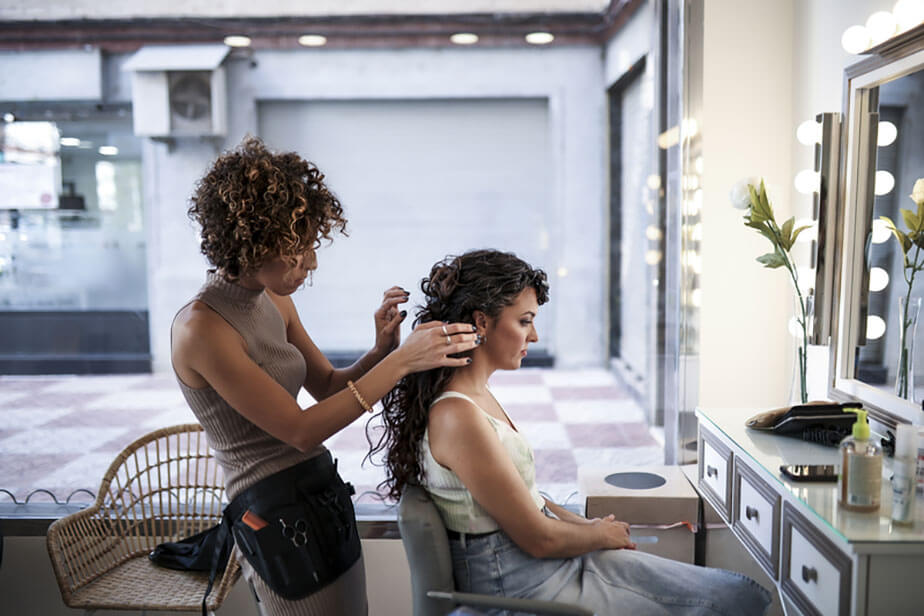Pblogallard/Dreamstime.com
For hair professionals, mastering the art of curly hair consultations requires understanding that each client’s journey with their curly hair routine is unique. A thorough consultation builds trust and ensures that clients receive personalized recommendations that address their specific needs and concerns.
Understanding the Consultation Environment
Creating the right environment for a curly hair consultation is crucial for its success. The consultation area should be well-lit, allowing for clear observation of the client’s natural curl pattern and hair health. A private, comfortable space lets clients openly discuss their hair concerns and goals. Having a mirror available helps clients actively participate in the assessment process, while proper lighting ensures an accurate evaluation of hair texture, density and scalp condition.
Initial Assessment and Client History
Before diving into the technical aspects, understanding your client’s hair history is essential. Discuss past chemical treatments, current styling practices and any challenges they face. Important factors to consider include their lifestyle, how much time they can dedicate to hair care and previous experiences with professional hair care products. This information helps shape realistic recommendations and identifies potential barriers to maintaining their desired hair routine.
Analyzing Curl Patterns and Texture
A comprehensive understanding of different types of curls is fundamental to providing accurate recommendations. Examine the client’s natural curl pattern, which can vary on various sections of the head. Consider factors such as strand thickness, density, porosity and elasticity. Remember that many clients may have multiple curl patterns and require different care approaches for different areas. Document these observations to create a tailored treatment plan.
Scalp Health Assessment
The foundation of healthy curly hair begins with a healthy scalp. Examine the scalp for signs of dryness, excess oil or other conditions that might affect hair health. Consider seasonal changes and environmental factors that might impact scalp condition, as well. This assessment helps you determine appropriate cleansing recommendations and whether your client should incorporate specialized scalp treatments into their care routine.
Product and Technique Recommendations
Consider the client’s specific needs, lifestyle and budget when recommending products. Focus on essential products that align with their skill level and time commitment. Demonstrate proper application techniques using appropriate amounts of product, explaining how different consistencies and ingredients work with their specific curl pattern. Offer guidance on product layering and the importance of maintaining proper moisture-protein balance.
Styling Education and Maintenance

Viacheslav Iacobchuk/Dreamstime.com
Education is crucial for long-term success. Show clients how to properly detangle their curls, apply products and style their hair to enhance their natural pattern. Demonstrate protective styling techniques that help maintain moisture and reduce manipulation. Discuss nighttime maintenance, such as using silk or satin pillowcases and proper wrapping techniques.
Managing Expectations and Follow-Up Care
Set realistic expectations about the time and dedication required to achieve and maintain your client’s desired results. Discuss the transition period if they are moving from heat-styled to natural curls, or if you recommend significant changes to their routine. Establish a clear follow-up plan to monitor progress and make necessary adjustments to their care routine.
Documentation and Progress Tracking
Maintain detailed records of consultations, including photos (with client permission), product recommendations and specific techniques discussed. This documentation helps track progress over time and ensures consistency in recommendations during future visits. Use these records to identify patterns in what works best for different curl types and textures.
Building Long-Term Relationships
A successful curly hair consultation extends beyond the initial meeting. Establish yourself as a trusted resource for ongoing curl care education and support. Consider offering check-in appointments to monitor progress and adjust recommendations as needed. This approach helps build lasting relationships and ensures clients continue to achieve their desired results.
Addressing Common Concerns and Challenges
Be prepared to address common curly hair challenges such as frizz, dryness and tangles. Provide solutions for situations like humidity management, workout recovery and seasonal changes. This proactive approach helps clients feel more confident in managing their curls.
Cultural Competency and Inclusivity
Understanding and respecting the cultural significance of different hair textures and styles is essential. Stay informed about diverse hair care practices and products suitable for various ethnic backgrounds. This knowledge helps provide more inclusive and culturally sensitive consultations while building trust with clients from different backgrounds.
Professional Development and Continued Education
Stay current with evolving curly hair care techniques, products and tools through continued education and professional development. Attend workshops, participate in online training and engage with the curly hair community to expand your expertise. This ongoing learning ensures you can provide the most up-to-date and effective recommendations to your clients.
Conclusion

Yuri Arcurs/Dreamstime.com
As the curly hair care industry continues to evolve, maintaining a comprehensive consultation process helps ensure client satisfaction and successful outcomes. By combining technical expertise with empathetic communication and ongoing education, you can provide valuable guidance that helps clients embrace and maintain their natural curls.










Share Your Feedback